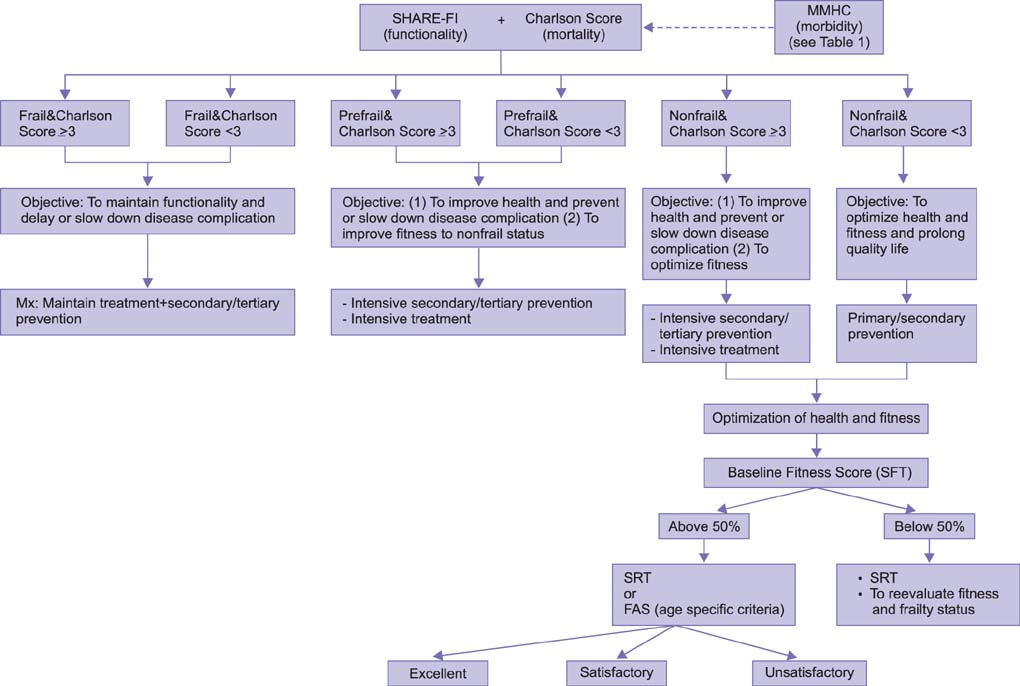Korean J Urol.
2014 Nov;55(11):710-717. 10.4111/kju.2014.55.11.710.
Men's Health Index: A Pragmatic Approach to Stratifying and Optimizing Men's Health
- Affiliations
-
- 1Department of Surgery, Sime Darby Medical Center, Subang Jaya, Malaysia.
- 2Department of Primary Care Medicine, Faculty of Medicine, University of Malaya, Kuala Lumpur, Malaysia.
- 3Department of Surgery, Thomas Jefferson University, Philadelphia, PA, USA.
- 4Department of Surgery, Queens University Belfast, Belfast, United Kingdom.
- 5Department of Surgery, Universiti Kebangsaan Malaysia Medical Centre, Kuala Lumpur, Malaysia. chrisckho@ppukm.ukm.edu.my
- KMID: 2069912
- DOI: http://doi.org/10.4111/kju.2014.55.11.710
Abstract
- PURPOSE
The proposed Men's Health Index (MHI) aims to provide a practical and systematic framework for comprehensively assessing and stratifying older men with the intention of optimising their health and functional status.
MATERIALS AND METHODS
A literature search was conducted using PubMed from 1980 to 2012. We specifically looked for instruments which: assess men's health, frailty and fitness; predict life expectancy, mortality and morbidities. The instruments were assessed by the researchers who then agreed on the tools to be included in the MHI. When there was disagreements, the researchers discussed and reached a consensus guided by the principle that the MHI could be used in the primary care setting targetting men aged 55-65 years.
RESULTS
The instruments chosen include the Charlson's Combined Comorbidity-Age Index; the International Index of Erectile Function-5; the International Prostate Symptom Score; the Androgen Deficiency in Aging Male; the Survey of Health, Ageing and Retirement in Europe Frailty Instrument; the Sitting-Rising Test; the Senior Fitness Test; the Fitness Assessment Score; and the Depression Anxiety Stress Scale-21. A pilot test on eight men was carried out and showed that the men's health index is viable.
CONCLUSIONS
The concept of assessing, stratifying, and optimizing men's health should be incorporated into routine health care, and this can be implemented by using the MHI. This index is particularly useful to primary care physicians who are in a strategic position to engage men at the peri-retirement age in a conversation about their life goals based on their current and predicted health status.
Keyword
MeSH Terms
Figure
Reference
-
1. Malcher G. The state of men's health in Europe. BMJ. 2011; 343:d7054.2. Romero-Ortuno R. The Frailty Instrument for primary care of the Survey of Health, Ageing and Retirement in Europe predicts mortality similarly to a frailty index based on comprehensive geriatric assessment. Geriatr Gerontol Int. 2013; 13:497–504.3. Jones CJ, Rikli RE. Measuring functional fitness of older adults. J Active Aging. 2002; 24–30.4. de Brito LB, Ricardo DR, de Araujo DS, Ramos PS, Myers J, de Araujo CG. Ability to sit and rise from the floor as a predictor of all-cause mortality. Eur J Prev Cardiol. 2012; 21:892–898.5. Charlson M, Szatrowski TP, Peterson J, Gold J. Validation of a combined comorbidity index. J Clin Epidemiol. 1994; 47:1245–1251.6. Charlson ME, Pompei P, Ales KL, MacKenzie CR. A new method of classifying prognostic comorbidity in longitudinal studies: development and validation. J Chronic Dis. 1987; 40:373–383.7. Vlachopoulos CV, Terentes-Printzios DG, Ioakeimidis NK, Aznaouridis KA, Stefanadis CI. Prediction of cardiovascular events and all-cause mortality with erectile dysfunction: a systematic review and meta-analysis of cohort studies. Circ Cardiovasc Qual Outcomes. 2013; 6:99–109.8. Wehrberger C, Temml C, Gutjahr G, Berger I, Rauchenwald M, Ponholzer A, et al. Is there an association between lower urinary tract symptoms and cardiovascular risk in men? A cross sectional and longitudinal analysis. Urology. 2011; 78:1063–1067.9. Kirby M, Chapple C, Jackson G, Eardley I, Edwards D, Hackett G, et al. Erectile dysfunction and lower urinary tract symptoms: a consensus on the importance of co-diagnosis. Int J Clin Pract. 2013; 67:606–618.10. Nehra A, Jackson G, Miner M, Billups KL, Burnett AL, Buvat J, et al. The Princeton III Consensus recommendations for the management of erectile dysfunction and cardiovascular disease. Mayo Clin Proc. 2012; 87:766–778.11. Thompson IM, Tangen CM, Goodman PJ, Probstfield JL, Moinpour CM, Coltman CA. Erectile dysfunction and subsequent cardiovascular disease. JAMA. 2005; 294:2996–3002.12. Araujo AB, Travison TG, Ganz P, Chiu GR, Kupelian V, Rosen RC, et al. Erectile dysfunction and mortality. J Sex Med. 2009; 6:2445–2454.13. Mulhall J, Teloken P, Barnas J. Vasculogenic erectile dysfunction is a predictor of abnormal stress echocardiography. J Sex Med. 2009; 6:820–825.14. Shabsigh R, Shah M, Sand M. Erectile dysfunction and mens health: developing a comorbidity risk calculator. J Sex Med. 2008; 5:1237–1243.15. Armitage JN, Sibanda N, Cathcart PJ, Emberton M, van der Meulen JH. Mortality in men admitted to hospital with acute urinary retention: database analysis. BMJ. 2007; 335:1199–1202.16. Mulligan T, Frick MF, Zuraw QC, Stemhagen A, McWhirter C. Prevalence of hypogonadism in males aged at least 45 years: the HIM study. Int J Clin Pract. 2006; 60:762–769.17. Kupelian V, Shabsigh R, Araujo AB, O'Donnell AB, McKinlay JB. Erectile dysfunction as a predictor of the metabolic syndrome in aging men: results from the Massachusetts Male Aging Study. J Urol. 2006; 176:222–226.18. Laaksonen DE, Niskanen L, Punnonen K, Nyyssonen K, Tuomainen TP, Valkonen VP, et al. Testosterone and sex hormone-binding globulin predict the metabolic syndrome and diabetes in middle-aged men. Diabetes Care. 2004; 27:1036–1041.19. USAF Fitness Test Scoring [Internet]. Randolph AFB, TX: Air Force Personnel Center;cited 2014 Jan 24. Available from: http://www.afpc.af.mil/shared/media/document/AFD-110804-054.pdf.20. Starfield B, Hyde J, Gervas J, Heath I. The concept of prevention: a good idea gone astray? J Epidemiol Community Health. 2008; 62:580–583.
- Full Text Links
- Actions
-
Cited
- CITED
-
- Close
- Share
- Similar articles
-
- The concepts and necessity of preconception care for men
- The World Journal of Men's Health Has Been Accepted for Coverage in Science Citation Index (SCI) Expanded
- Changing Men's Health: Leading the Future
- Vision and Strategies for Men's Health Research in an Aging Society
- The Role of the Urologist in Men's Health


